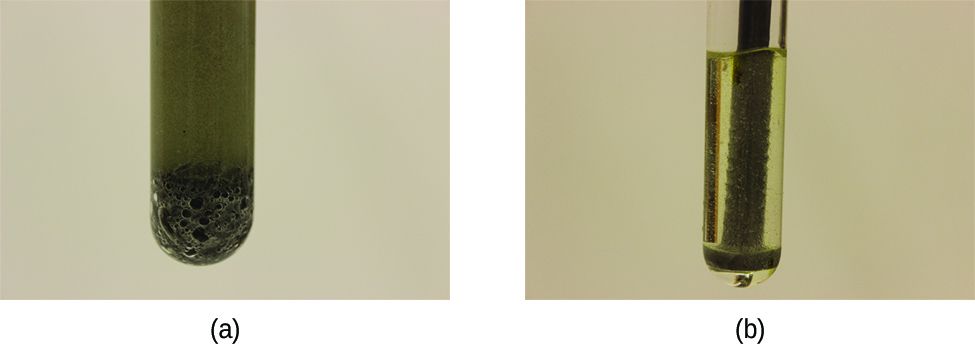102 Factors Affecting Reaction Rates
[latexpage]
Learning Objectives
By the end of this section, you will be able to:
- Describe the effects of chemical nature, physical state, temperature, concentration, and catalysis on reaction rates
The rates at which reactants are consumed and products are formed during chemical reactions vary greatly. Five factors typically affecting the rates of chemical reactions will be explored in this section: the chemical nature of the reacting substances, the state of subdivision (one large lump versus many small particles) of the reactants, the temperature of the reactants, the concentration of the reactants, and the presence of a catalyst.
The Chemical Nature of the Reacting Substances
The rate of a reaction depends on the nature of the participating substances. Reactions that appear similar may have different rates under the same conditions, depending on the identity of the reactants. For example, when small pieces of the metals iron and sodium are exposed to air, the sodium reacts completely with air overnight, whereas the iron is barely affected. The active metals calcium and sodium both react with water to form hydrogen gas and a base. Yet calcium reacts at a moderate rate, whereas sodium reacts so rapidly that the reaction is almost explosive.
The Physical States of the Reactants
A chemical reaction between two or more substances requires intimate contact between the reactants. When reactants are in different physical states, or phases (solid, liquid, gaseous, dissolved), the reaction takes place only at the interface between the phases. Consider the heterogeneous reaction between a solid phase and either a liquid or gaseous phase. Compared with the reaction rate for large solid particles, the rate for smaller particles will be greater because the surface area in contact with the other reactant phase is greater. For example, large pieces of iron react more slowly with acids than they do with finely divided iron powder ((Figure)). Large pieces of wood smolder, smaller pieces burn rapidly, and saw dust burns explosively.

Watch this video to see the reaction of cesium with water in slow motion and a discussion of how the state of reactants and particle size affect reaction rates.
Temperature of the Reactants
Chemical reactions typically occur faster at higher temperatures. Food can spoil quickly when left on the kitchen counter. However, the lower temperature inside of a refrigerator slows that process so that the same food remains fresh for days. Gas burners, hot plates, and ovens are often used in the laboratory to increase the speed of reactions that proceed slowly at ordinary temperatures. For many chemical processes, reaction rates are approximately doubled when the temperature is raised by 10 °C.
Concentrations of the Reactants
The rates of many reactions depend on the concentrations of the reactants. Rates usually increase when the concentration of one or more of the reactants increases. For example, calcium carbonate (CaCO3) deteriorates as a result of its reaction with the pollutant sulfur dioxide. The rate of this reaction depends on the amount of sulfur dioxide in the air ((Figure)). An acidic oxide, sulfur dioxide combines with water vapor in the air to produce sulfurous acid in the following reaction:
Calcium carbonate reacts with sulfurous acid as follows:
In a polluted atmosphere where the concentration of sulfur dioxide is high, calcium carbonate deteriorates more rapidly than in less polluted air. Similarly, phosphorus burns much more rapidly in an atmosphere of pure oxygen than in air, which is only about 20% oxygen.

Phosphorous burns rapidly in air, but it will burn even more rapidly if the concentration of oxygen is higher. Watch this video to see an example.
The Presence of a Catalyst
Relatively dilute aqueous solutions of hydrogen peroxide, H2O2, are commonly used as topical antiseptics. Hydrogen peroxide decomposes to yield water and oxygen gas according to the equation:
Under typical conditions, this decomposition occurs very slowly. When dilute H2O2(aq) is poured onto an open wound, however, the reaction occurs rapidly and the solution foams because of the vigorous production of oxygen gas. This dramatic difference is caused by the presence of substances within the wound’s exposed tissues that accelerate the decomposition process. Substances that function to increase the rate of a reaction are called catalysts, a topic treated in greater detail later in this chapter.
Chemical reactions occur when molecules collide with each other and undergo a chemical transformation. Before physically performing a reaction in a laboratory, scientists can use molecular modeling simulations to predict how the parameters discussed earlier will influence the rate of a reaction. Use the PhET Reactions & Rates interactive to explore how temperature, concentration, and the nature of the reactants affect reaction rates.
Key Concepts and Summary
The rate of a chemical reaction is affected by several parameters. Reactions involving two phases proceed more rapidly when there is greater surface area contact. If temperature or reactant concentration is increased, the rate of a given reaction generally increases as well. A catalyst can increase the rate of a reaction by providing an alternative pathway with a lower activation energy.
Chemistry End of Chapter Exercises
Describe the effect of each of the following on the rate of the reaction of magnesium metal with a solution of hydrochloric acid: the molarity of the hydrochloric acid, the temperature of the solution, and the size of the pieces of magnesium.
Higher molarity increases the rate of the reaction. Higher temperature increases the rate of the reaction. Smaller pieces of magnesium metal will react more rapidly than larger pieces because more reactive surface exists.
Explain why an egg cooks more slowly in boiling water in Denver than in New York City. (Hint: Consider the effect of temperature on reaction rate and the effect of pressure on boiling point.)
Go to the PhET Reactions & Rates interactive. Use the Single Collision tab to represent how the collision between monatomic oxygen (O) and carbon monoxide (CO) results in the breaking of one bond and the formation of another. Pull back on the red plunger to release the atom and observe the results. Then, click on “Reload Launcher” and change to “Angled shot” to see the difference.
(a) What happens when the angle of the collision is changed?
(b) Explain how this is relevant to rate of reaction.
(a) Depending on the angle selected, the atom may take a long time to collide with the molecule and, when a collision does occur, it may not result in the breaking of the bond and the forming of the other. (b) Particles of reactant must come into contact with each other before they can react.
In the PhET Reactions & Rates interactive, use the “Many Collisions” tab to observe how multiple atoms and molecules interact under varying conditions. Select a molecule to pump into the chamber. Set the initial temperature and select the current amounts of each reactant. Select “Show bonds” under Options. How is the rate of the reaction affected by concentration and temperature?
In the PhET Reactions & Rates interactive, on the Many Collisions tab, set up a simulation with 15 molecules of A and 10 molecules of BC. Select “Show Bonds” under Options.
(a) Leave the Initial Temperature at the default setting. Observe the reaction. Is the rate of reaction fast or slow?
(b) Click “Pause” and then “Reset All,” and then enter 15 molecules of A and 10 molecules of BC once again. Select “Show Bonds” under Options. This time, increase the initial temperature until, on the graph, the total average energy line is completely above the potential energy curve. Describe what happens to the reaction.
(a) very slow; (b) As the temperature is increased, the reaction proceeds at a faster rate. The amount of reactants decreases, and the amount of products increases. After a while, there is a roughly equal amount of BC, AB, and C in the mixture and a slight excess of A.
Glossary
- catalyst
- substance that increases the rate of a reaction without itself being consumed by the reaction

